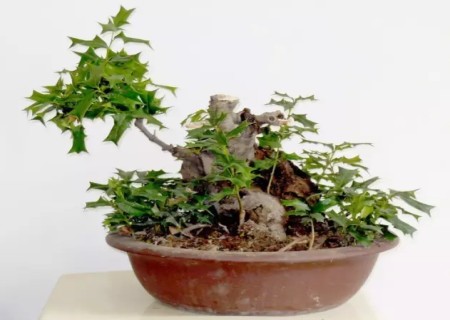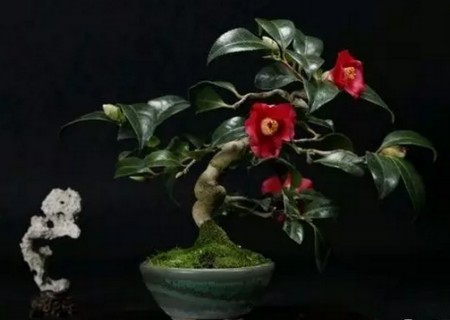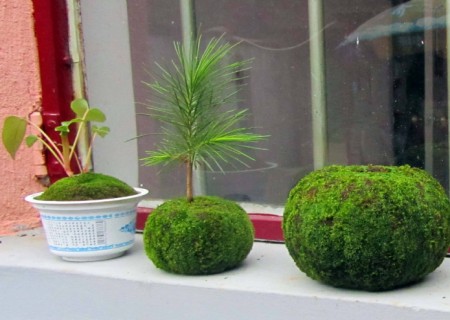The method of making star anise bonsai
Star anise thorn, also known as wolfbone, bird does not sleep, belongs to holly family, single leaf alternate, hard leathery, the edge has needle teeth, evergreen all seasons. Sex like light, but also slightly resistant to shade, not resistant to severe cold, slow growth, developed root system, strong germination, resistance to pruning, unisexual heterosexual, drupe globular, bright red in autumn and winter, is a good bonsai material for leaf viewing, flower viewing and fruit viewing.
Star anise thorn branches and leaves luxuriant, leaf shape is strange, especially after autumn red fruit is numerous, bright and beautiful, is the excellent flower variety. So, how do star anise thorns make bonsai? Let's follow the editor to learn the method of making star anise bonsai.

1. Draw materials
The main sources of star anise bonsai materials are: sowing, cutting, high pressure, mountain mining and so on. Due to the slow growth of star anise thorn, thick, old, Qiu qu, beautiful roots, well-branched piles generally rely on mountain mining. Star anise thorns are distributed in the provinces of the middle and lower reaches of the Yangtze River and generally grow near mountain streams with lower altitude. The mining time is available all year round, with the best in early spring and the worst in severe winter and heat. When mining, we should carefully examine the pile, choose a better pile head mining, do not pick the pile as soon as you see it, let alone cut and dig randomly.
The fibrous root of star anise thorn is less, and it is not easy to carry soil, so try to protect the fine root as far as possible, and the big root should be longer to facilitate water conservation. When the dry wind is strong, the pile billet dug should pay attention to shade and moisturizing, and try not to damage the root and bark during transportation.
2. Production
The cut should be cut flat and smeared with clean yellow mud or auxin, and the larger cut in the upper part of the pile blank should be wrapped with black plastic film to facilitate wound healing.
It can be planted on the ground or directly in the pot. it is better to use the soil basin when planting in the pot. it can also be planted in purple sand basin or cement basin, with loose and breathable soil such as rotten leaf soil or garden soil.
After pouring through the water, tie it tightly with a basin cover with a white plastic bag, keep it in a semi-shady place, and often check the humidity of the basin soil to keep it moist.
After the pile billet sprouts, choose rainy days or high humidity cloudy days, open the plastic bag to gradually adapt; sunny and dry days to spray water to the pile head to moisturize, can also be appropriate shade.
Star anise thorn pile billet survive, do not rush to thinning branches, more branches and leaves, evaporate more water, can promote the growth of roots. After entering the normal management stage, it should be maintained in an all-day place to enhance the adaptability of the pile billet, gradually reduce the new leaves, remove excess branches after autumn, and apply thin fertilizer to ensure that the plant is strong through the winter.
Banding is carried out in the second or third year, and the time is chosen in spring. The hard thorns on the leaves can cut off the leaves of the whole plant and fasten them again, and leaf cutting can also promote multiple branches. Leave a petiole when cutting leaves to prevent damage to leaf buds and affect leaf bud germination. When banding, the thread can not damage the leaf bud. After the branches are fixed, release the wire in time. When removing the wire, you can use wire scissors to cut the wire separately, and then remove it with sharp-nosed pliers.
Note:
1. Star anise thorns should be planted in pots after autumn or before sprouting in spring. When digging seedlings, attention must be paid to protecting lateral roots and whisker roots. It is difficult to survive only with main roots, so it is best to transplant them with soil balls, and at the same time, branches and leaves should be thinned properly to reduce water consumption.
2. The basin soil should use slightly acidic, neutral or calcareous soil with loose fertility and good permeability, commonly used rotten leaf soil or mature pastoral soil, mixed with appropriate amount of sandy soil.
3. Star anise likes the acid and fertile soil with plenty of sunshine, warm climate and good drainage, which has poor cold resistance and slow growth. it is necessary to apply more phosphate fertilizer to make the fruit dense and bright.
4. Star anise thorn is not resistant to severe cold, and when the temperature of the overwintering plant is below zero in winter, anti-freezing measures should be taken.
Time: 2019-05-26 Click:
- Prev

How to make tea plum bonsai
Camellia is an evergreen shrub of the family Theaceae, which is called Camellia because its flower pattern has the characteristics of both camellias and plum blossoms. In the Ming Dynasty, Gao Lian wrote a song "Plum Blossom Ling Tea Plum": the flower is, with Meihun, a few strokes, writing the charm of tea plum, both like camellias and plum blossoms.
- Next

Diagram of self-made method of DIY for bonsai with moss jade balls
Moss jade, fresh and elegant, evergreen all the year round, is more ornamental than meat. At present, it is very popular in Europe, the United States, Japan and South Korea. Moss jade is not only a kind of plant, but also a kind of planting method, an ancient Japanese art evolved from bonsai, which began in the Edo period of Japan and belongs to a kind of Japanese bonsai.
Related
- Fuxing push coffee new agricultural production and marketing class: lack of small-scale processing plants
- Jujube rice field leisure farm deep ploughing Yilan for five years to create a space for organic food and play
- Nongyu Farm-A trial of organic papaya for brave women with advanced technology
- Four points for attention in the prevention and control of diseases and insect pests of edible fungi
- How to add nutrient solution to Edible Fungi
- Is there any good way to control edible fungus mites?
- Open Inoculation Technology of Edible Fungi
- Is there any clever way to use fertilizer for edible fungus in winter?
- What agents are used to kill the pathogens of edible fungi in the mushroom shed?
- Rapid drying of Edible Fungi

